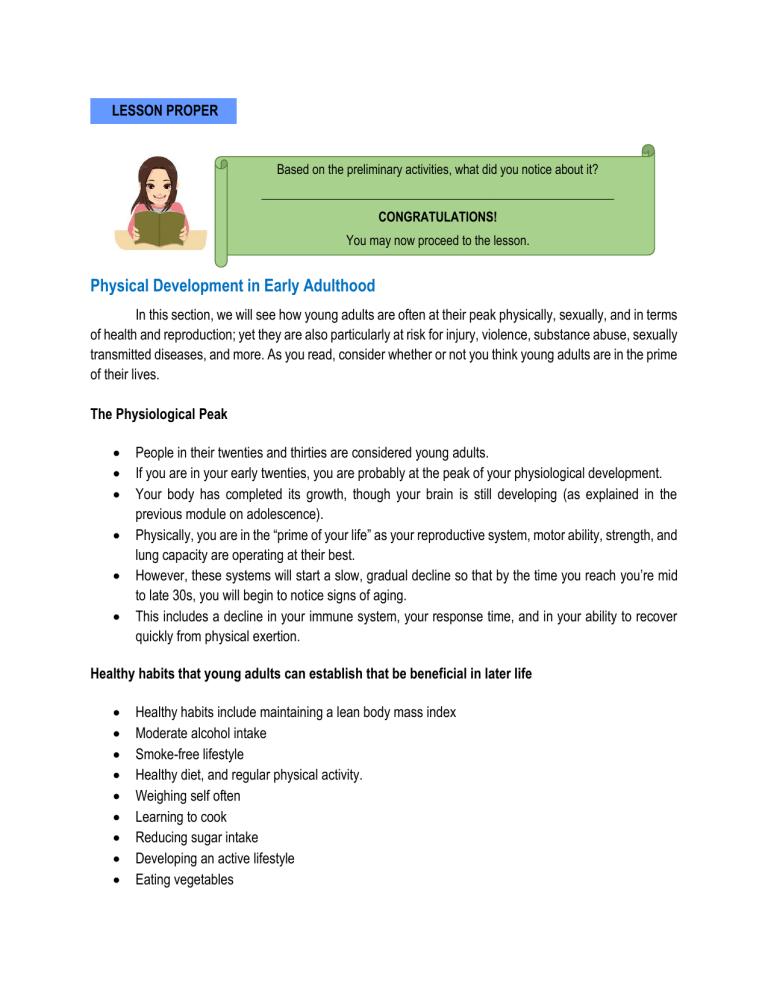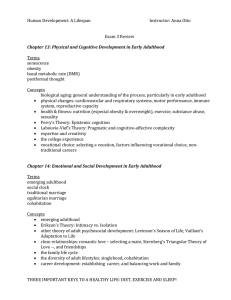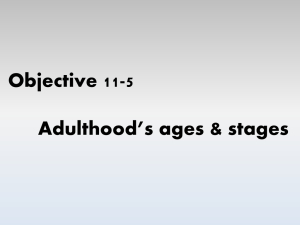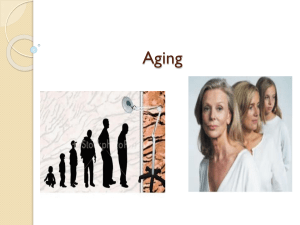
LESSON PROPER Based on the preliminary activities, what did you notice about it? ________________________________________________________ CONGRATULATIONS! You may now proceed to the lesson. Physical Development in Early Adulthood In this section, we will see how young adults are often at their peak physically, sexually, and in terms of health and reproduction; yet they are also particularly at risk for injury, violence, substance abuse, sexually transmitted diseases, and more. As you read, consider whether or not you think young adults are in the prime of their lives. The Physiological Peak People in their twenties and thirties are considered young adults. If you are in your early twenties, you are probably at the peak of your physiological development. Your body has completed its growth, though your brain is still developing (as explained in the previous module on adolescence). Physically, you are in the “prime of your life” as your reproductive system, motor ability, strength, and lung capacity are operating at their best. However, these systems will start a slow, gradual decline so that by the time you reach you’re mid to late 30s, you will begin to notice signs of aging. This includes a decline in your immune system, your response time, and in your ability to recover quickly from physical exertion. Healthy habits that young adults can establish that be beneficial in later life Healthy habits include maintaining a lean body mass index Moderate alcohol intake Smoke-free lifestyle Healthy diet, and regular physical activity. Weighing self often Learning to cook Reducing sugar intake Developing an active lifestyle Eating vegetables Practicing portion control Finding a job you love.[1] A Healthy, but Risky Time Substance Abuse Rates of violent death are influenced by substance abuse, which peaks during early adulthood. Some young adults use drugs and alcohol as a way of coping with stress from family, personal relationships, or concerns over being on one’s own. Others “use” because they have friends who use and in the early 20s, there is still a good deal of pressure to conform. Youth transitioning into adulthood have some of the highest rates of alcohol and substance abuse. Sexual Responsiveness Men and women tend to reach their peak of sexual responsiveness at different ages. For men, sexual responsiveness tends to peak in the late teens and early twenties. Sexual arousal can easily occur in response to physical stimulation or fantasizing. Sexual responsiveness begins a slow decline in the late twenties and into the thirties although a man may continue to be sexually active throughout adulthood. Over time, a man may require more intense stimulation in order to become aroused. Women often find that they become more sexually responsive throughout their 20s and 30s and may peak in the late 30s or early 40s. This is likely due to greater self-confidence and reduced inhibitions about sexuality. Reproduction For many couples, early adulthood is the time for having children. However, delaying childbearing until the late 20s or early 30s has become more common in the United States. The mean age of first-time mothers in the United States increased 1.4 years, from 24.9 in 2000 to 26.3 in 2014. This shift can primarily be attributed to a larger number of first births to older women along with fewer births to mothers under age 20. Couples delay childbearing for a number of reasons. Women are now more likely to attend college and begin careers before starting families. And both men and women are delaying marriage until they are in their late 20s and early 30s. Infertility Male factors create infertility in about a third of the cases. For men, the most common cause is a lack of sperm production or low sperm production. Female factors cause infertility in another third of cases. For women, one of the most common causes of infertility is ovulation disorder. Other causes of female infertility include blocked fallopian tubes, which can occur when a woman has had pelvic inflammatory disease (PID) or endometriosis. PID is experienced by 1 out of 7 women in the United States and leads to infertility about 20 percent of the time. One of the major causes of PID is Chlamydia, the most commonly diagnosed sexually transmitted infection in young women. Another cause of pelvic inflammatory disease is gonorrhea. Both male and female factors contribute to the remainder of cases of infertility and approximately 20 percent are unexplained. Fertility Treatment The majority of infertility cases (85-90 percent) are treated using fertility drugs to increase ovulation or with surgical procedures to repair the reproductive organs or remove scar tissue from the reproductive tract. In vitro fertilization (IVF) is used to treat infertility in less than 5 percent of cases. IVF is used when a woman has blocked or deformed fallopian tubes or sometimes when a man has a very low sperm count. This procedure involves removing eggs from the female and fertilizing the eggs outside the woman’s body. The fertilized egg is then reinserted in the woman’s uterus. Less common procedures include gamete intrafallopian tube transfer (GIFT) which involves implanting both sperm and ova into the fallopian tube and fertilization is allowed to occur naturally. Zygote intrafallopian tube transfer (ZIFT) is another procedure in which sperm and ova are fertilized outside of the woman’s body and the fertilized egg or zygote is then implanted in the fallopian tube. This allows the zygote to travel down the fallopian tube and embed in the lining of the uterus naturally. Fertility for Singles and Same-Sex Couples The journey to parenthood may look different for singles same-sex couples. However, there are several viable options available to them to have their own biological children. Men and women may choose to donate their sperm or eggs to help others reproduce for monetary or humanitarian reasons. Some gay couples may decide to have a surrogate pregnancy. One or both of the men would provide the sperm and choose a carrier. The chosen woman may be the source of the egg and uterus or the woman could be a third party that carries the created embryo. Artificial insemination (AI) is the deliberate introduction of sperm into a female’s cervix or uterine cavity for the purpose of achieving a pregnancy through in vivo fertilization by means other than sexual intercourse. AI is most often used by single women who desire to give birth to their own child, women who are in a lesbian relationship, or women who are in a heterosexual relationship but with a male partner who is infertile or who has a physical impairment which prevents intercourse. The sperm used could be anonymous or from a known donor. Developmental Tasks of Early Adulthood The beginning of early adulthood, ages 18-25, is sometimes considered its own phase, emerging adulthood, but the developmental tasks that are the focus during emerging adulthood persist throughout the early adulthood years. Look at the list below and try to think of someone you know between 18 and 40 who fits each of the descriptions. Havighurst (1972) describes some of the developmental tasks of young adults. These include: Achieving autonomy: trying to establish oneself as an independent person with a life of one’s own Establishing identity: more firmly establishing likes, dislikes, preferences, and philosophies Developing emotional stability: becoming more stable emotionally which is considered a sign of maturing Establishing a career: deciding on and pursuing a career or at least an initial career direction and pursuing an education Finding intimacy: forming first close, long-term relationships Becoming part of a group or community: young adults may, for the first time, become involved with various groups in the community. They may begin voting or volunteering to be part of civic organizations (scouts, church groups, etc.). This is especially true for those who participate in organizations as parents. Establishing a residence and learning how to manage a household: learning how to budget and keep a home maintained. Becoming a parent and rearing children: learning how to manage a household with children. Making marital or relationship adjustments and learning to parent. Cognitive Development in Early Adulthood Beyond Formal Operational Thought: Post formal Thought In the adolescence module, we discussed Piaget’s formal operational thought. The hallmark of this type of thinking is the ability to think abstractly or to consider possibilities and ideas about circumstances never directly experienced. Thinking abstractly is only one characteristic of adult thought, however. If you compare a 14-year-old with someone in their late 30s, you would probably find that the later considers not only what is possible, but also what is likely. Why the change? The young adult has gained experience and understands why possibilities do not always become realities. This difference in adult and adolescent thought can spark arguments between the generations. Piaget’s theory of cognitive development ended with formal operations, but it is possible that other ways of thinking may develop after (or “post”) formal operations in adulthood (even if this thinking does not constitute a separate “stage” of development). Postformal thought is practical, realistic and more individualistic, but also characterized by understanding the complexities of various perspectives. As a person approaches the late 30s, chances are they make decisions out of necessity or because of prior experience and are less influenced by what others think. Of course, this is particularly true in individualistic cultures such as the United States. Postformal thought is often described as more flexible, logical, willing to accept moral and intellectual complexities, and dialectical than previous stages in development. Perry’s Scheme One of the first theories of cognitive development in early adulthood originated with William Perry (1970) , who studied undergraduate students at Harvard University. Perry noted that over the course of students’ college years, cognition tended to shift from dualism (absolute, black and white, right and wrong type of thinking) to multiplicity (recognizing that some problems are solvable and some answers are not yet known) to relativism (understanding the importance of the specific context of knowledge—it’s all relative to other factors). Dialectical Thought Some adults may move even beyond the relativistic or contextual thinking described by Perry; they may be able to bring together important aspects of two opposing viewpoints or positions, synthesize them, and come up with new ideas. This is referred to as dialectical thought and is considered one of the most advanced aspects of postformal thinking (Basseches, 1984). There isn’t just one theory of postformal thought; there are variations, with emphasis on adults’ ability to tolerate ambiguity or to accept contradictions or find new problems, rather than solve problems, etc. (as well as relativism and dialecticism that we just learned about). Career Choices in Early Adulthood Hopefully, we are each becoming lifelong learners, particularly since we are living longer and will most likely change jobs multiple times during our lives. However, for many, our job changes will be within the same general occupational field, so our initial career choice is still significant. We’ve seen with Erikson that identity largely involves occupation and, as we will learn in the next section, Levinson found that young adults typically form a dream about work (though females may have to choose to focus relatively more on work or family initially with “split” dreams). One of the most well-known theories about career choice is from John Holland (1985), who proposed that there are six personality types (realistic, investigative, artistic, social, enterprising, and conventional), as well as varying types of work environments. The better matched one’s personality is to the workplace characteristics, the more satisfied and successful one is predicted to be with that career or vocational choice. Research support has been mixed and we should note that there is more to satisfaction and success in a career than one’s personality traits or likes and dislikes. For instance, education, training, and abilities need to match the expectations and demands of the job, plus the state of the economy, availability of positions, and salary rates may play practical roles in choices about work We had just finished the discussion on Early Adulthood (Physical and Cognitive Development). Let’s move on to the next higher level of activity/ies or exercise/s that demonstrate your potential skills/knowledge of what you have learned.





